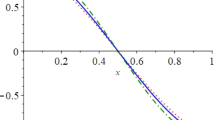Abstract
We remind of the history of the transportation (Kantorovich) metric and the Monge-Kantorovich problem. We also describe several little-known applications: the first one concerns the theory of decreasing sequences of partitions (tower of measures and iterated metric), the second one relates to Ornstein's theory of Bernoulli automorphisms (d¯-metric), and the third one is the formulation of the strong Monge-Kantorovich problem in terms of matrix distributions. Bibliography: 29 titles
Similar content being viewed by others
REFERENCES
A. Barvinok, A Course in Convexity, Amer. Math. Soc., Providence, Rhode Island (2002).
Y. Brennier, “Extended Monge-Kantorovich theory,” Lecture Notes in Math., 1813, 91–122 (2003).
M. Emery, “Espaces probabilises filtres: de la theorie de Vershik au mouvement brownien, via les idees de Tsirelson,” Seminaire BOURBAKI, No. 882 (2000).
U. Frish, Turbulence. The Legacy of A. N. Kolmogorov, Cambridge Univ. Press, Cambridge (1995).
W. Gangbo and R. J. McCann, “The geometry of optimal transportation,” Acta Math., 177, No.2, 113–161 (1966).
M. L. Gavurin and L. V. Kantorovich, “Application of mathematical methods to problems of analysis of freight flows,” in: Problems of Raising the Efficiency of Transport Performance [in Russian], Moscow-Leningrad (1949), pp. 110–138.
M. Gromov, Metric Structures for Riemannian and Non-Riemannian Spaces, Birkhauser, Boston (1999).
L. V. Kantorovich, Mathematical Methods in the Organization and Planning of Production [in Russian], Leningrad (1939).
L. V. Kantorovich, “On an efficient method of solving some classes of extremal problems,” Dokl. Akad. Nauk SSSR, 28, No.3, 212–215 (1940).
L. V. Kantorovich, “On the translocation of masses,” Dokl. Akad. Nauk SSSR, 37, Nos. 7–8, 227–229 (1942).
L. V. Kantorovich, “On a problem of Monge,” Uspekhi Mat. Nauk, 3, No.2, 225–226 (1948).
L. V. Kantorovich, “Functional analysis and applied mathematics,” Uspekhi Mat. Nauk, 3, No.6, 89–185 (1948).
L. V. Kantorovich, Economical Calculation of the Best Use of Resources [in Russian], Moscow (1960).
L. V. Kantorovich, “On new approaches to computational methods and processing of observations,” Sib. Mat. Zhurn., 3, No.5, 701–709 (1962).
L. V. Kantorovich and G. Sh. Rubinshtein, “On a space of totally additive functions,” Vestn Lening. Univ., 13, No.7, 52–59 (1958).
Leonid Vitalievich Kantorovich: Man and Scientist, vol. 1, Novosibirsk (2002).
D. Ornstein, Ergodic Theory, Randomness, and Dynamical Systems, Yale Univ. Press, New Haven-London (1974).
S. T. Rachev, Probability Metrics and the Stability of Stochastic Models, Wiley, Chichecter (1991).
A. M. Vershik, “Some remarks on infinite-dimensional problems of linear programming,” Uspekhi Mat. Nauk, 25, No.5, 117–124 (1970).
A. M. Vershik, “Decreasing sequences of measurable partitions and their applications,” Sov. Math. Dokl., 11, No.4, 1007–1011 (1970).
A. M. Vershik, “On D. Ornstein's papers, weak dependence conditions and classes of stationary measures,” Theory Probab. Appl., 21 (1977), 655–657.
A. M. Vershik, “Multivalued mappings with invariant measure (polymorphisms) and Markov operators,” J. Sov. Math., 23, 2243–2266 (1983).
A. M. Vershik, “Theory of decreasing sequences of measurable partitions,” St. Petersburg Math. J., 6, No.4, 705–761 (1994).
A. M. Vershik, “Dynamic theory of growth in groups: entropy, boundaries, examples,” Russian Math. Surveys, 55, No.4, 667–733 (2000).
A. M. Vershik, “Classification of measurable functions of several arguments, and invariantly distributed random matrices,” Funct. Anal. Appl., 36, No.2, 93–105 (2002).
A. M. Vershik, “About L. V. Kantorovich and linear programming,” in: Leonid Vitalievich Kantorovich: Man and Scientist, vol. 1, Novosibirsk (2002), pp. 130–152.
A. Vershik, “Polymorphims, Markov processes, quasi-similarity of K-automorphisms,” to appear in Discrete Contin. Dyn. Syst.
A. M. Vershik and M. M. Rubinov, “General duality theorem in linear programming,” in: Mathematical Economics and Functional Analysis [in Russian], Nauka, Moscow (1974), pp. 35–55.
C. Villani, Topics in Optimal Transportation, Amer. Math. Soc., Providence, Rhode Island (2000).
Author information
Authors and Affiliations
Additional information
__________
Translated from Zapiski Nauchnykh Seminarov POMI, Vol. 312, 2004, pp. 69–85.
Rights and permissions
About this article
Cite this article
Vershik, A.M. Kantorovich Metric: Initial History and Little-Known Applications. J Math Sci 133, 1410–1417 (2006). https://doi.org/10.1007/s10958-006-0056-3
Received:
Issue Date:
DOI: https://doi.org/10.1007/s10958-006-0056-3




